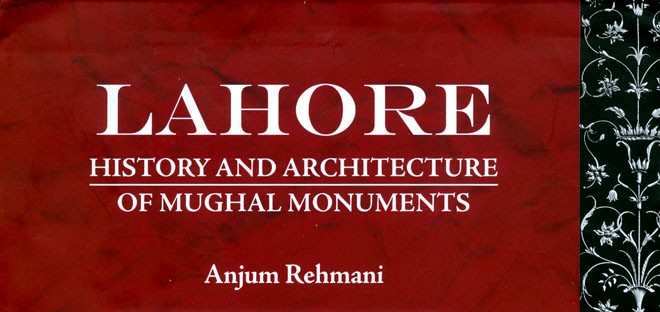
Anjum Rehmani writes a reliable account of the city’s history and architecture

The city of Lahore has more admirers than can be counted, so overcome by their love for the city that they keep writing about its treasures, ethos, heritage and history. One old admirer is Anjum Rehmani who has written on Lahore, focusing on its history and the architecture of Mughal monuments.
Though the book may be focusing on the Mughal monuments and that period, it also provides a lot of information about Lahore preceding the Mughal period, with special attention being paid to how the city came to be named and founded. He is eminently qualified to write about the city as he holds two PhD degrees and has been working with the Lahore Museum for years, slowly rising to be its director. He has also written many books including one on Punjab, which adds to our knowledge about the province’s culture and history.
Rehmani, like any true historian, heavily relies on evidence and documentation. If he is not satisfied with a particular explanation or source, he brings to our attention other sources that are available on the origins of the city. These sources including monographs, documents and scraps of information available on the origins of the city are compiled in Rehmani’s literature review. The literature review serves a two-pronged purpose: apart from giving the book depth, it also places the reader on a vantage point from where it is easy to check if information is being repeated or if something revelatory has been added.
The evidence of two dynasties that ruled this area, Chaach and Hindu Shiaah, has largely been lost to history. A degree of continuity can only be traced from the 11th century, towards the end of the Ghaznavid rule. But the settlement is older than the 11th century. Some say that in the area we now know as Lahore, there was a small town named Mandakakur. Others believe that there was a fortification called the Thunpur Fort, where Lahore lies today. The book also talks about temples that existed in this area, such as Bhairon ka Thaan and Chandraar.
According to Rehmani, the name Lahore first appeared by the end of ninth century. It is believed that at that time, the area was ruled by the son of Bhindra who belonged to the Chaach Dynasty. The second ruler of the Chaach dynasty, Raja Bunrat, built a temple in Lahore and displayed in it a statue of Aftab -- the Sun God. This is a claim made by Fakhr Mudabbir, the author of Adaab-ul-Harb which was written during the reign of Qutubuddin Aibak. Rehmani, in his book, disagrees with this. Although many believe that this temple could have been located in Ichrra, Rehmani puts more value to the speculation that it was located in Miani Sahib Graveyard, because it was here that statues of Shiv and Parvati were recently unearthed.
Generally, it is assumed that Lahore is named after Raja Loh, the son of Ramchandar. This claim is supported by a 17th century writer, Sujin Rai. According to historian Colonel Rashid, however, the name was first La-Ur, meaning the ‘House of God’ named by the founding Hurris, an Aryan clan. Alexander Burns thought the city was named after Lahore, the slave of Alexander. For Iranian scholar Aqa-i-Subhi, the name was derived from lav and hoor - in Iran lav means city, and hoor means sun. Others believe it was Lahanur, lighted by God Almighty instead of a sun god. For still others, the name was derived from loh, meaning iron, associated with harvesting.
Rehmani is very clear about the fact that Lahore’s architecture was not a regional derivative of the grand Mughal architecture that bloomed in Delhi, Agra and Fatehpur Sikri. Instead it had its own autonomous status and can be called a distinct style in its own right. Since it can stand its ground and is not an imitation of the grand monuments of the Gangetic plains, it should not be confused with any other style. With its overlapping arches, high Persian domes, tall minarets and substantial vaulted roofs, Lahore’s architecture stands out. The minarets, in most cases, tower high above the front arches and the main domes. The domes invariably crown the mass of the building, giving structures a bold and dignified look. The elaborate and intricate panelings and paintings inside the buildings create a rich appearance; most of Lahore’s buildings are embellished dominantly in Iranian type kashi kari work.
The edition is profusely illustrated: it has coloured photographs and architectural drawings. It is narrated in a chronological order which makes it easier to place the monuments in their historical context. He also discusses why monuments were raised on particular spots.
In the last few years, the cost of buying books has shown an appreciable increase. Similarly, the book under review is also beyond the purchasing power of many despite their thirst for knowledge. As it is, people here do not read and thus the general level of education is low and information outdated. One plausible reason for people not reading may be the affordability factor, since they cannot afford to buy books for thousands of rupees. It can be understood that because of inflation, cost of publishing is rising, but there should be some intervention to reduce the price of books.
Authors receive next to nothing for writing while readers are paying through their noses; so one wonders where the profits go. Reducing the price of books is a noble cause as it will allow people to buy and keep books for reference.